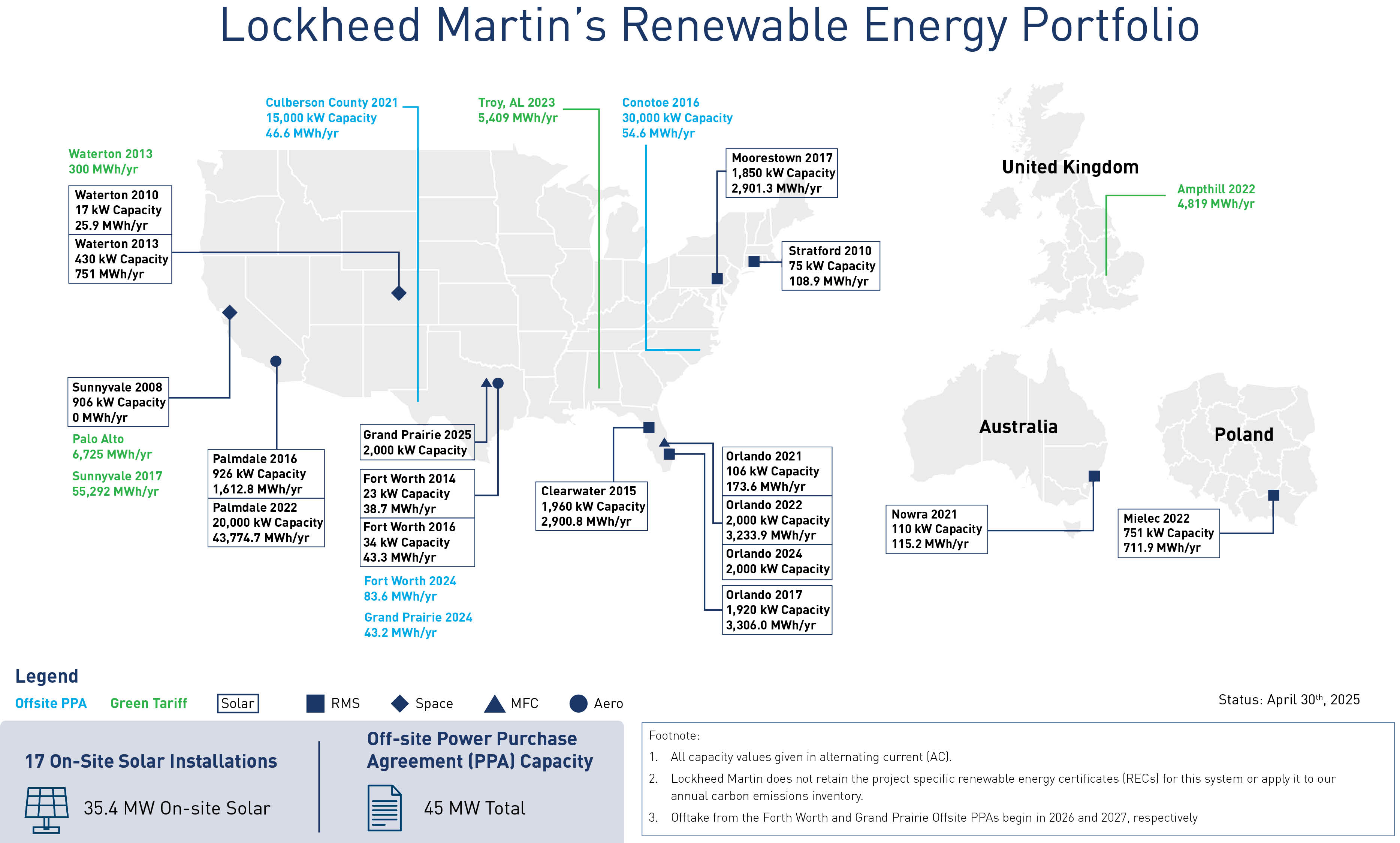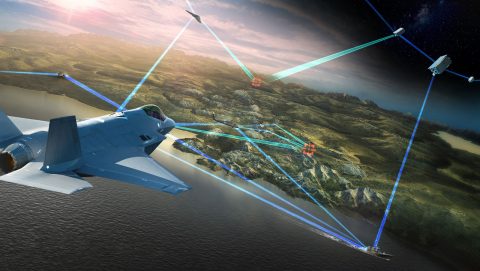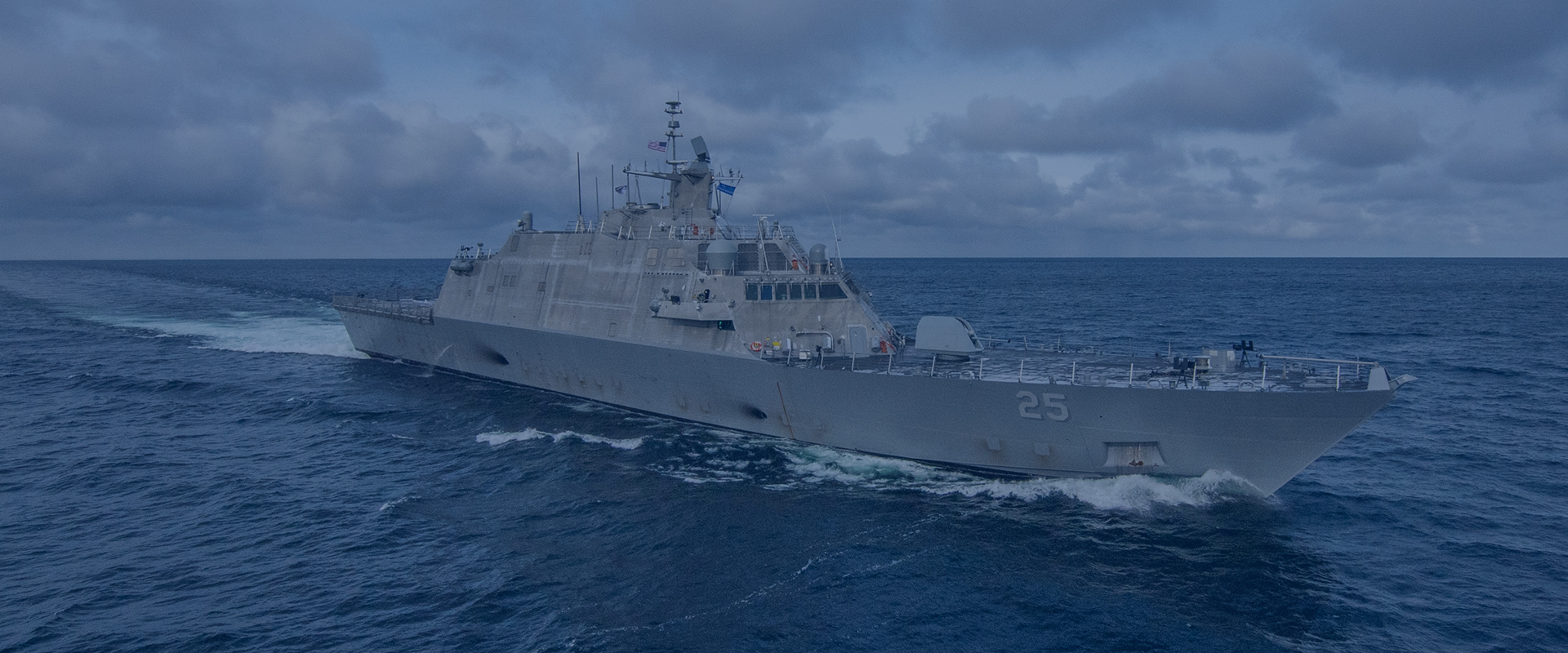Lockheed Martin recognizes the importance of effective strategic decarbonization programs and management of climate-related risk. We regularly explore opportunities to take more aggressive action to reduce our carbon emissions and increase our commitment to renewable energy sources. Our current goals were established following a thorough analysis of our operational footprint, technical opportunities and investment requirements. We used subject matter experts across all responsible functions, including sustainability, facilities, capital planning, energy and each of our business areas.



Our Executive Leadership team and Board of Directors recognize the investment required to achieve these accelerated goals and the need to incorporate these commitments into our long-range business plans. We also recognize that more ambitious targets are needed to continue progress beyond 2030. With this in mind, we have programs and governance structures in place to ensure that we regularly monitor performance and continue to evolve our carbon strategy and carbon reduction efforts over time.
Risk Analysis and Disclosures
Multiple resources detail our climate-related risk analysis and disclosures, including our Task Force on Climate-related Financial Disclosures (TCFD) report and Carbon Disclosure Project (CDP) Climate Change report. We published our inaugural TCFD-aligned report in 2020; our updated 2024 report includes a variety of external and internal data to serve as the foundation to expand on our qualitative analysis. Our CDP Climate Change report provides additional documentation that aligns with TCFD disclosures and details our progress toward our decarbonization goals.
Our expanded analysis focuses on physical climate-related risks and the impact of carbon emissions on transitional risks; we have established the total value at risk for all physical risk hazards. We also have estimated transitional risk impacts on operational and supplier cost based on fixed carbon pricing and projected pricing relative to established climate scenarios based on shared socioeconomic pathways.
Fleet Fuel Efficiency
As part of Lockheed Martin’s commitment to reducing emissions, we have been phasing in zero-emission vehicles (ZEVs). Notably, we concluded 2024 with a total of 25 ZEV vans between our Sunnyvale and Palmdale locations.
Addressing Scope 3 Emissions
Lockheed Martin was one of the earliest in the aerospace and defense industry to perform a high-level economic input-output life cycle analysis of cradle-to-gate to better understand environmental impacts throughout our supply chain. This analysis was completed and disclosed for the first time in our 2012 CDP response. We continuously work to refine our Scope 3 emissions methodologies using recognized standards and the latest available data sets, and we disclose those emissions annually through our CDP Climate Change report.
Measuring Our Scope 3 Emissions
Purchased goods and services
- Estimates are calculated by categorizing purchase order data by North American Industry Classification System (NAICS) code, then applying the US Environmental Protection Agency (USEPA) emissions factor associated with each NAICS code. New for 2024, we’ve included regional emissions factors from Exiobase to represent import of foreign goods, which have been compiled by the USEPA.
Capital goods
- Estimates are calculated by categorizing purchase order data by North American Industry Classification System (NAICS) code, then applying the US Environmental Protection Agency (USEPA) emissions factor associated with each NAICS code. New for 2024, we’ve included regional emissions factors from Exiobase to represent import of foreign goods, which have been compiled by the USEPA.
Fuel and energy-related activities (not included in Scopes 1 and 2)
- Transmission and distribution (T&D) losses associated with natural gas are calculated using emissions factors provided by EPA for natural gas use in global operations, with the exception of the U.K. (BEIS/DEFRA).
- T&D losses for electricity for Canada and Australia operations are estimated using country-specific emissions factors provided by Carbonfootprint.com. U.K. electricity-based T&D losses provided by U.K. BEIS/DEFRA
- T&D losses for electricity use are included in United States Scope 2 data by default through the use of EPA eGrid factors and are not included in Scope 3 data.
Upstream transmission and distribution of goods
Business travel
- Personal auto reimbursement emissions are calculated by multiplying the total miles reimbursed by the average auto passenger mile factor in the United States provided by the EPA. U.K. emissions are calculated using U.K. (BEIS/DEFRA) emissions factors per mile.
- Fuel usage represents all fuel use (including rental cars) and is calculated based on the average national price per gallon of gasoline in the United States and U.K. to estimate volume per $USD. The fuel volume is multiplied by the average automobile fuel efficiency by year and the emissions factor per mile. Emissions factors are provided by U.S. EPA and U.K. (BEIS/DEFRA).
- Airline emissions are obtained from our corporate travel provider and are based on distance traveled and number of segments multiplied by the respective emissions factor by geography from U.S. EPA and U.K. (BEIS/DEFRA).
Employee commuting
- Workforce datasets are compiled in coordination with Lockheed Martin’s HR function to include distance traveled, schedule, and telecommuting status.
- Standard commuting distances are now compiled monthly to reflect short-term changes in status’ and to capture sub-annual variations in workforce numbers regionally.
- Telecommuting FTE-hrs are compiled based on schedule and telecommuting status, also on a monthly basis to reflect changes.
- Regional (EU), national (AU, CA, UK) and state (US) level commuter distributions by mode of travel are compiled and aligned with the appropriate emissions factors from USEPA and U.K. (BEIS/DEFRA). This method allows Lockheed Martin to assign a weighted average emissions factor inclusive of all travel modes and unique to each geographic jurisdiction, while also enabling more detailed ability to track behavioral changes at a sub-national level.
- Telecommuting method is based on U.K. (BEIS/DEFRA) guidance and emissions factors. Non-U.K. estimates for telecommuting are augmented to reflect the electricity based difference in carbon intensity geographically vs. the UK average.
Waste generated in operations
Use of sold products
- Emissions from use of sold products are estimated by conducting applied life cycle assessment calculations based on emission intensity by product or fuel use of our top revenue-producing programs with tangible product deliveries and are aligned with the Greenhouse Gas Protocol.
- Aircraft (fixed-wing and rotary) produce more than 99% of our estimated emissions for this category.
- Datasets for product deliveries align with quarter financial reporting and represent a reporting year of Oct.-Sept. 2019-2022 values are restated to reflect the temporal adjustments to quarterly reporting best aligned with our Greenhouse Gas reporting year of Nov.-Oct.
Aerospace and defense companies face industry-specific challenges when addressing both upstream and downstream Scope 3 emissions. The defense industrial base relies on a highly specialized and complex supply chain. In addition, our customers define product specification and fully dictate the ultimate use of our products. Lockheed Martin recognizes that any action to reduce Scope 3 emissions requires strong industry collaboration and expanded customer engagement.
Despite the complex and unique challenges faced by our industry, we are taking action to address Scope 3 emissions. We continue to estimate and report Scope 3 emissions across the eight categories relevant to our business in our Performance Index. To strengthen the quality of our Scope 3 emissions calculations, we will increase primary emissions data collection, setting a target to implement by 2025 a third-party validated supplier sustainability assessment program to include outreach to suppliers representing 60% of our spend. This supplier engagement goal was achieved early in 2024.
We are also engaging in the following activities that target emission reductions across multiple Scope 3 categories:
Supply Chain Resources and Partnerships
- We support and educate suppliers in the aerospace and defense industry on the adoption of renewable electricity through the Lockheed Martin RENEWAY program, a partnership with Schneider Electric.
- We actively participate with our industry peers in the International Aerospace Environmental Group (IAEG) to strengthen education, resources and partnerships across the aerospace and defense value chain with activities. In 2023, we elevated our role as a co-lead of the IAEG ESG Engagement work group. The focus of this work group is to deploy and maintain an enduring aerospace industry voluntary standard, with the support of a proven third-party solution, for assessing sustainability practices that enables informed business decisions, duty of care compliance obligations, reporting, and positive change in environmental and social topics.
Product Innovation and Customer Use
We continue to develop products that reduce customer emissions. Research, development, test and evaluation related to propulsion enhancements are ongoing, including electrification, hydrogen and sustainable aviation fuel use, as well as light weighting and enhanced technologies to reduce overall flight time. Examples include:
- Approved use of synthetic aviation turbine fuels (SATF) in the F-35 Lightning II, allowing the aircraft to operate on new fuel blends improving readiness by reducing reliance on the extended supply chain. More than 1,100 F-35s are currently in operation around the globe.
- Successful execution of a commercial biofuel flight demonstration of 1,500 miles using a Sikorsky S-92.
- Production of the Hybrid-Electric Demonstrator, a fully-autonomous hybrid-electric vertical-take-off-and-landing prototype with ranges greater than 500 nautical miles.
- Collaboration between NASA and Lockheed Martin to develop the Quiet Supersonic Technology (Quesst) X-plane to pave the way for supersonic flight over land. The Quesst design is one of a series of X-planes envisioned in NASA's New Aviation Horizons initiative, which aims to reduce fuel use, emissions and noise through innovations in aircraft design that depart from the conventional tube-and-wing aircraft shape.
- Development and launch of our flexible Multi-mission Modular Solar Array and application to NASA’s Vertical Solar Array Technology to harness solar energy and thus build and sustain a long-term lunar presence.
- Applied aircraft flight simulation that balances live training with mission preparation in the virtual world, reducing risk to our soldiers and avoiding actual flight hours to drive down operational and fuel costs and associated emissions. With the introduction of the Amorphic Appearance Zero-Projector visual display system AMAZE, Lockheed Martin is further reducing the physical footprint needed to conduct high-fidelity training, saving on costs, space and overall use of facilities needed across the globe.
- One of the largest virtual reality laboratories of its kind, Lockheed Martin’s Collaborative Human Immersive Laboratory, which is enabling collaboration between product design and manufacturing teams before physically designing and producing hardware for human spaceflight, imaging satellites and solar array facilities. We analyze designs and manufacturing processes in virtual worlds prior to physical manufacturing. This allows engineers and technicians to validate, test and understand products and processes, as well as their efficiency, early in program development.
- We engage with the White House and the U.S. Department of Defense to discuss shared challenges and collaboration opportunities.
Climate Lobbying Assessment
Lockheed Martin is committed to participating in the political and public policy process in a responsible and ethical way that serves the best interests of our stockholders and customers. Additionally, Lockheed Martin contributes to select public policy debates by participating in trade and industry associations. We detail and disclose extensive information on our Political Disclosures website about our political and public policy activities well beyond what is required by law.
In accordance with our sustainability governance processes, Lockheed Martin regularly evaluates the public policy positions of selected trade and industry associations that we are members of and assess their alignment with our sustainability policy and program.
Our climate lobbying assessment methodology includes the following:
- Develop a selected list of relevant trade associations for evaluation, defined as those memberships with annual dues of $25,000 or more and whose remit is national.
- Evaluate the public climate positions of each identified trade association through website research.
- Publish the results of our evaluation in section 12.3 of our CDP Climate Change report.



